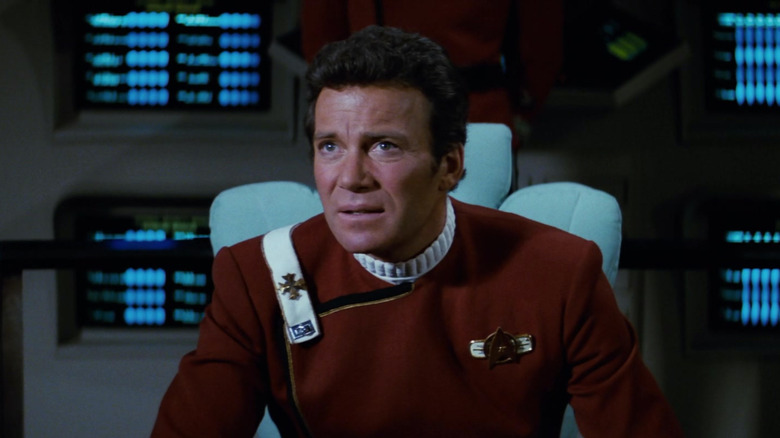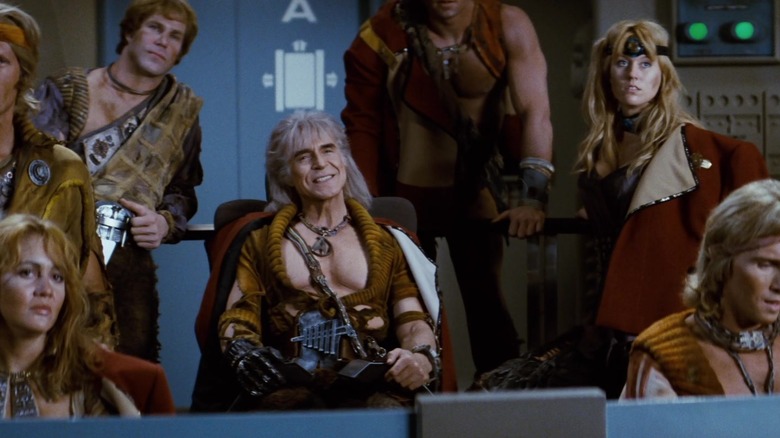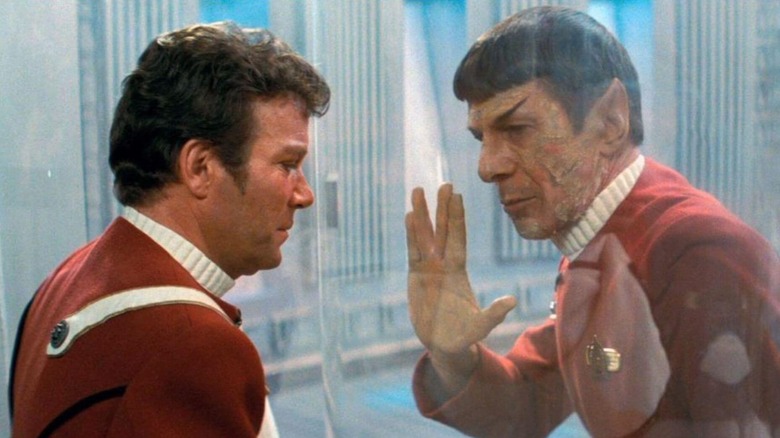The Real Reason Star Trek II: The Wrath Of Khan Kept Kirk & Khan Separate
One of the best bits of advice any writer will give you is to make yourself familiar with as many tropes, cliches and conventions as possible. That way, you can understand how they work while also knowing just when to ignore them. One convention seen in just about all of fiction is the idea that the protagonist and antagonist must share at least one, if not many, moments together, culminating in a final altercation in which the hero emerges victorious over the villain. It's a trope so common that not only is it not questioned, it's routinely expected, so much so that when it's missing, it seems initially like it could be a mistake. Of course, there are many examples of novels, TV shows, and films where this convention is subverted or even ignored, yet it becomes more difficult to do so when an artist is working within the confines of genre.
Space opera is a genre where such subversion has to be done carefully, lest you leave the audience unsatisfied. When "Star Trek II: The Wrath of Khan" was being made in the early 1980s, it was dealing with mounting issues of potential audience dissatisfaction. The prior film, "Star Trek: The Motion Picture," had defiantly gone its own way with a number of bold creative choices, leaving fans suspicious of a sequel, and this movie's decision to bring back the villain Khan Noonien Singh (Ricardo Montalbán), last seen on the "Star Trek" episode entitled "Space Seed," was already building up the idea of a wrestling-style rematch between him and Admiral James T. Kirk (William Shatner). Hell, the film's subtitle even alluded to a similarly revenge-oriented sequel released a few years earlier, "Star Wars: Episode V — The Empire Strikes Back," in which that film's hero and villain shared a climactic and fateful one-on-one duel.
Most impressively, director (and uncredited co-writer) Nicholas Meyer chose to take another direction than the expected one with the film. In "The Wrath of Khan," Kirk and Khan never meet face-to-face, a choice made not just for subversion's sake. It actually allowed Meyer to not have to deal with one particular issue between the characters — one that could have possibly derailed the whole film.
For Meyer, revenge is a dish best served from afar
At first glance, the choice to keep Kirk and Khan physically separated for the duration of "The Wrath of Khan" seems like a canny one. After all, the choices each captain makes greatly impacts the other, so much so that having them share the same space seems almost redundant. There's even precedent for this structure within the "Star Trek" series itself. The 14th episode of the first season, "Balance of Terror," sees Kirk and the Enterprise go up against a Romulan vessel, their entire altercation taking place without the crew or captains ever meeting in person. That episode happened to be greatly influenced by the 1957 film "The Enemy Below," directed by Dick Powell and starring Robert Mitchum. In that movie, Mitchum's submarine captain matches cat-and-mouse wits with a German U-boat commander played by Curd Jürgens.
If that sounds familiar, then it won't be a surprise that "The Enemy Below" was a huge influence on Meyer and "Wrath of Khan," too. As Meyer told TrekMovie recently, he admired how Mitchum and Jürgens' characters "never meet. It's just their weapons that meet." Yet Meyer wasn't merely paying homage to "The Enemy Below." He also sought to use it as a template so as to avoid having Kirk and Khan physically fight one another, as they had during "Space Seed," because he found the idea of a bout between a human and a genetically enhanced warrior to be too ridiculous. As he explained to TrekMovie:
"I do know that they wanted to have a mano a mano, a fight between Kirk and Khan. And I said, 'Well, they tried that in 'Space Seed' and it looked phony and stupid to me.' Khan is a superman. Kirk wouldn't stand a chance against him. It just seemed kind of corny [...] So I resisted the idea of this mano a mano shootout, or whatever it was supposed to be."
Distance between Kirk and Khan makes the tension grow
Meyer doesn't specify who the "they" is in his quote that wanted to see a physical rematch between Kirk and Khan; he could be referring to anyone from his fellow filmmakers to studio executives or to "Star Trek" fans themselves. Although "The Wrath of Khan" was only Meyer's second film as director, he already had a keen understanding of what makes a cat-and-mouse chase work best dramatically. His second film as a screenwriter, "The Seven-Per-Cent Solution," pitted Sherlock Holmes against a Moriarity who may or may not be a delusion, and his first directing effort, "Time After Time," followed H.G. Wells as he chased Jack the Ripper into the 20th century. In place of such externalized metaphysical obstacles as those, Meyer depicts the struggle between Kirk and Khan more metaphorically, as the two captains use their crews and their technology to battle each other in place of their fists.
The separation between Kirk and Khan also increases the dramatic tension of the story, the fact of their physical distance from each other becoming a source of frustration for both men. One of the ingenious elements within Meyer's version of the script (adapted from Jack B. Sowards' credited draft) concerns how Kirk and Khan's superiority complex and rage-fueled arrogance leaves them both at a loss by the end of the film: neither Kirk nor Khan get true, complete satisfaction over the other. It is Spock (Leonard NImoy), through an act of self-sacrifice and dedication, who proves himself the master of the "Kobayashi Maru" test, winning the un-winnable scenario. Through this choice, "The Wrath of Khan" gets to have such delicious cake and eat it too, providing enough rip-roaring drama and spaceship explosions to satisfy the baser elements of the genre while still containing an aspirational and morally progressive message, an element that's a staple of "Star Trek." In everything from cliched dramatic structure to doomsday devices, Meyer and "The Wrath of Khan" proves that there is another way.


